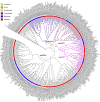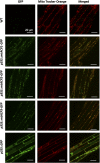Mitochondrial Fatty Acid Synthase Utilizes Multiple Acyl Carrier Protein Isoforms
- PMID: 32094306
- PMCID: PMC7271772
- DOI: 10.1104/pp.19.01468
Mitochondrial Fatty Acid Synthase Utilizes Multiple Acyl Carrier Protein Isoforms
Abstract
Acyl carrier protein (ACP) is a highly conserved cofactor protein that is required by Type II fatty acid synthases (FASs). Here, we demonstrate that up to three mitochondrial ACP (mtACP) isoforms support the Arabidopsis (Arabidopsis thaliana) mitochondrially localized Type II FAS. The physiological importance of the three mtACPs was evaluated by characterizing the single, double, and triple mutants. The mtACP1 (At2g44620), mtACP2 (At1g65290), and mtACP3 (At5g47630) single mutants showed no discernible morphological growth phenotype. Functional redundancy among the three mtACPs was indicated by the embryo-lethal phenotype associated with simultaneous loss of all three mtACP genes. Characterization of all double mutant combinations revealed that although the mtacp1 mtacp3 and mtacp2 mtacp3 double mutant combinations showed no observable growth defect, the mtacp1 mtacp2 double mutant was viable but displayed delayed growth, reduced levels of posttranslationally lipoylated mitochondrial proteins, hyperaccumulation of photorespiratory Gly, and reduced accumulation of many intermediates in central metabolism. These alterations were partially reversed when the mtacp1 mtacp2 double mutant plants were grown in a nonphotorespiratory condition (i.e. 1% CO2 atmosphere) or in the presence of 2% Suc. In summary, mtACP, as a key component of mitochondrial fatty acid biosynthesis, is important in generating the fatty acid precursor of lipoic acid biosynthesis. Thus, the incomplete lipoylation of mitochondrial proteins in mtacp mutants, particularly Gly decarboxylase, affects the recovery of photorespiratory carbon, and this appears to be critical during embryogenesis.
© 2020 American Society of Plant Biologists. All Rights Reserved.
Figures







Comment in
-
Functional Analysis of Mitochondrial Acyl Carrier Proteins.Plant Physiol. 2020 Jun;183(2):421-422. doi: 10.1104/pp.20.00559. Plant Physiol. 2020. PMID: 32493799 Free PMC article. No abstract available.
Similar articles
-
Dual-Localized Enzymatic Components Constitute the Fatty Acid Synthase Systems in Mitochondria and Plastids.Plant Physiol. 2020 Jun;183(2):517-529. doi: 10.1104/pp.19.01564. Epub 2020 Apr 3. Plant Physiol. 2020. PMID: 32245791 Free PMC article.
-
A phosphopantetheinyl transferase that is essential for mitochondrial fatty acid biosynthesis.Plant J. 2015 Nov;84(4):718-32. doi: 10.1111/tpj.13034. Plant J. 2015. PMID: 26402847
-
Discovery and Characterization of the 3-Hydroxyacyl-ACP Dehydratase Component of the Plant Mitochondrial Fatty Acid Synthase System.Plant Physiol. 2017 Apr;173(4):2010-2028. doi: 10.1104/pp.16.01732. Epub 2017 Feb 15. Plant Physiol. 2017. PMID: 28202596 Free PMC article.
-
Mitochondrial acyl carrier protein (ACP) at the interface of metabolic state sensing and mitochondrial function.Biochim Biophys Acta Mol Cell Res. 2019 Dec;1866(12):118540. doi: 10.1016/j.bbamcr.2019.118540. Epub 2019 Aug 29. Biochim Biophys Acta Mol Cell Res. 2019. PMID: 31473256 Review.
-
Mitochondrial fatty acid synthesis and respiration.Biochim Biophys Acta. 2010 Jun-Jul;1797(6-7):1195-202. doi: 10.1016/j.bbabio.2010.03.006. Epub 2010 Mar 11. Biochim Biophys Acta. 2010. PMID: 20226757 Review.
Cited by
-
Cuticle development and the underlying transcriptome-metabolome associations during early seedling establishment.J Exp Bot. 2024 Oct 30;75(20):6500-6522. doi: 10.1093/jxb/erae311. J Exp Bot. 2024. PMID: 39031128 Free PMC article.
-
Functional Relationships of Two NFU Proteins in Maintaining the Abundances of Mitochondrial Iron-Sulfur Proteins.Plant Direct. 2025 May 29;9(5):e70081. doi: 10.1002/pld3.70081. eCollection 2025 May. Plant Direct. 2025. PMID: 40443787 Free PMC article.
-
Structural and Functional Perspectives on Mitochondrial LYR-Domain Proteins in Plants.Physiol Plant. 2025 Jul-Aug;177(4):e70393. doi: 10.1111/ppl.70393. Physiol Plant. 2025. PMID: 40654039 Free PMC article.
-
Dual-Localized Enzymatic Components Constitute the Fatty Acid Synthase Systems in Mitochondria and Plastids.Plant Physiol. 2020 Jun;183(2):517-529. doi: 10.1104/pp.19.01564. Epub 2020 Apr 3. Plant Physiol. 2020. PMID: 32245791 Free PMC article.
-
Isolation and comparative proteomic analysis of mitochondria from the pulp of ripening citrus fruit.Hortic Res. 2021 Feb 1;8(1):31. doi: 10.1038/s41438-021-00470-w. Hortic Res. 2021. PMID: 33518707 Free PMC article.
References
-
- Benjamini Y, Hochberg Y(1995) Controlling the false discovery rate: A practical and powerful approach to multiple testing. J R Stat Soc Series B Stat Methodol 57: 289–300
Publication types
MeSH terms
Substances
LinkOut - more resources
Full Text Sources
Molecular Biology Databases
Research Materials
Miscellaneous

